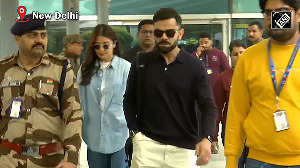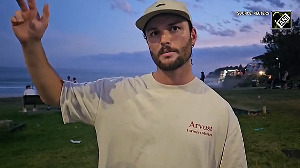When you see a wailing ambulance trying to wade its way through peak-hour traffic, have you ever wondered why don't they employ air ambulances instead? Like they did in that Hollywood movie you saw last week?
Well, that Hollywood movie experience might soon turn into reality right here in India.
TopsGrup, known for it security services, has launched what it calls India's largest air ambulance service: Tops Air Rescue.
"We want to create the equivalent of the 911 services of the United States or the 999 services of the United Kingdom. We started with an emergency service in Mumbai that will reach you in 9 minutes flat. What we did successfully on road, now we want to do with the air ambulance service," TopsGrup chairman and managing director Diwan Rahul Nanda says.
The service will connect the country through one network.
"We can pick up an ailing person from anywhere in India and fly him to any hospital in the country. The major difference between other services and us is that, we have a team of aviation medical experts. This means the ailing person will be completely taken care of till the time he/she is reached to the hospital," said chief operating officer Dr Prabhat Jauhari.
But while they reach you on time, these services come at a cost, and can leave you poorer by Rs 75,000 an hour; on an average, a rescue operation may cost around Rs 3 lakh (Rs 300,000).
However, Nanda says that money shouldn't matter.
"When it is about the life of a dear one, people never think about the money. Look at it this way. . . an emergency arises where a spouse needs urgent medical attention. Normally, you wouldn't even know who or where to call. But now, all help is just one phone call away," Nanda said.
So, what exactly does the air ambulance do?
To start with, there are different aircraft for different situations -- from a Cessna Citation II for distances up to 2000 km to Bell helicopters if your destination is not more than 250 km far.
"These aircraft are specially configured to act as a flying intensive care unit. You won't be able to tell the difference between the interiors of these planes and a hospital room. We have all the facilities, only the equipment will be smaller than the normal ones you see in hospitals," Jauhari says.
The services are categorised thus:
- Private ambulance (which is most well-equipped and most expensive);
- Medical escort service (this is for situations where the patients are medically stable, but need basic medical services. Medical personnel accompany the patient every step of the way. A separate aircraft is not required.);
- Commercial airline stretcher (the company arranges for a block of seats (usually six) to be removed from a commercial aircraft. The patient is put in a stretcher with a privacy curtain. A medical team flies along with the patient.)
So how does it work?
"It all depends on how urgent the patient requires the services. Once we get a call, we decide what kind of facilities would be required for the particular case. Since we don't own the aircraft and we charter them, we call for a plane from the nearest base," Jauhari explains.
As the plane takes off from the base, the patient is moved to the nearest air base. "We have to move the patient to a suitable airfield. The Directorate-General of Civil Aviation will soon amend their laws, after which helicopters will be allowed to land on highways and school grounds," Jauhari says.
As the patient reaches the destination airfield, a vehicle is ready to take him to the hospital. "All the while, the patient will be taken care of. . . till the time he reaches the hospital bed."
Within a month after it was launched, TopsGrup has had five clients, two of whom suffered strokes, but were rushed to Mumbai on time and are now back to normal.
The company has even flown two Italians back home -- one had suffered an accident in Darjeeling, while the other was a diplomat in the Mumbai mission and suffered multiple fractures.
"Both of them wanted to go back to Italy as soon as possible as the treatment was free and the public hospitals in Italy are really great," Jauhari says.
If all this sounds interesting and you are thinking 'what if. . ,' well there is a catch that you'll have to factor in.
Assuming you are capable of paying the average Rs 3 lakh (Rs 300,000), the plane will not take off from the base station unless you have remitted the fee in advance.
There is no way around this, claims Nanda. "I would like to do this for free. But since the flights are charted, there is nothing we can do about the costs. Also the services of the expert doctors do cost us a lot. The bulk of the cost incurred by the patient goes to the charter company. Our profit margin is very low," he insists.
We asked Jauhari how this pitfall can be overcome so that the service will be useful for the common man too; not just the rich.
Insurance, he says, is the only way out.
"We had approached all the leading insurers before the launch. Nobody was ready to take it up. The sad fact is that, in developed countries, medical insurance covers air rescue services too," he says.
Nanda, too, is perturbed. But, he is hopeful that things will change for good in a year or two.
"When we started other services too, people laughed at us. But, to me it is simple. Some time in my life, I can look back at this venture and tell my grandchildren that I saved so many lives."
External link: https://topsairrescue.com





